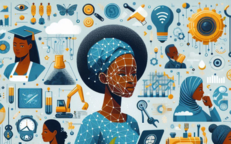Leveraging Smart Technologies To Tackle Gender-Based Violence In Africa

This is the 21st post in a blog series to be published in 2022 by the Secretariat on behalf of the AU High-Level Panel on Emerging Technologies (APET) and the Calestous Juma Executive Dialogues (CJED)
Gender-based violence (GBV) is defined as harmful acts committed against a person based on their gender. This could result in physical, sexual, and psychological harm. Whether occurring in public or private life[1], threats, coercion, and arbitrary deprivation of liberty constitute gender-based violence. Notably, both men and women are experiencing and being affected by gender-based violence. However, the majority of victims of gender-based violence have been women and girls. In Africa, gender-based violence is one of the numerous obstacles preventing women from exercising their fundamental rights to life, human dignity, peace, justice, socioeconomic development, and political advancement.[2]
Frameworks such as the African Union's Agenda 2063, the African Union's Strategy for Gender Equality and Women's Empowerment[3], the Maputo Protocol[4] to the African Charter on Human and People's Rights on the Rights of Women in Africa, and the Solemn Declaration on Gender Equality in Africa (SDGEA) ensure Africa's commitment to gender equality[5]. This is accomplished through the resolution and abolition of violence against women and girls, as well as increased access to resources such as finance, land, education, health, information services, science and technology, and decision-making in socio-political governance and commercial ventures[6]. The framework for Gender Equality and Women's Empowerment also envisions equal participation in African country advancement and the development of people-driven economies[7].
Nevertheless, despite the adoption of these progressive policies and legal frameworks to eradicate gender-based violence, this phenomenon remains the most pervasive violation of human rights in Africa[8]. Notably, approximately 736 million women aged 15 or older around the world have experienced some form of gender-based violence at least once in their lives, and one-third (30%) have experienced it more than once.[9] As a result, gender-based discrimination poses health risks, particularly for women and girls in Africa, and significantly contributes to the morbidity and mortality of women in Africa.
Africa remains one of the regions with the highest prevalence of gender-based violence, with approximately 36% of women having experienced it[10]. In some instances, these women are subjected to pervasive and enduring gender-based violations, such as child marriage and female genital mutilation[11]. Notably, at least one-third of women between the ages of 20 and 24 were forced into marriage before the age of 18 in 19African nations. Additionally, at least one-third of women between the ages of 15 and 49 have undergone female genital mutilation. Notably, the prevalence of GBV in Africa can be attributed to fostered patriarchy, cultural gender norms, low literacy levels, poverty, wars, regional and tribal conflicts, and limited levels of information[12].
The high prevalence of gender-based violence in Africa has resulted in widespread public support for the abolition of gender-based violence[13]. African governments have initiated and implemented some efforts to end gender-based violence. However, these efforts have been hampered by ineffective and incompetent coordination, as well as limited budgetary provisions for prevention and services. In South Africa, for example, political changes and limited funding mechanisms[14] have made it difficult for the National Council on Gender-Based Violence (NCGBV) council to draft, cost, and implement the national strategic plan to prevent gender-based violence. As a result, improved mechanisms for facilitating and coordinating preventive measures against gender-based violence should be developed and implemented.
To that end, the African Union High-Level Panel on Emerging Technologies (APET) advises African countries to consider adopting smart technologies to eliminate gender-based violence in Africa. APET believes that African countries' current methodologies and mechanisms to combat gender-based violence could be supplemented with smart technologies to strengthen the fight against gender-based violence. The spread and implementation of digital technologies can open up new avenues for addressing gender-based violence in novel ways and ensuring easier access to information and services needed to prevent gender-based violence. This can particularly enhance the impact of interventions and address gaps and challenges inherent in the delivery of traditional gender-based violence mitigation mechanisms.
When assisting victims of gender-based violence, certain gender-based technological solutions can assist African nations in enhancing safety and privacy standards and bolstering the foundations of ethical norms and regulations. APET acknowledges that substantial barriers prevent marginalised groups experiencing gender-based violence and impoverished women from gaining access to information and communication technologies. As a result, barriers such as cost, illiteracy, cultural norms, safety, and limited awareness of available communication tools exacerbate the digital divide in Africa.
APET advises African governments to improve gender equality through the use of smart technologies strategically. This can improve the technological resources available to law enforcement and prevent perpetrators of gender-based violence from monitoring, harassing, threatening, intimidating, impersonating, and stalking existing and potential victims. These smart technologies can also be used to prevent cyberbullying by enhancing the preventative cyberbullying law enforcement mechanisms and controls.
For example, South Africa's departments of Communications and Digital Technologies and Social Development, in partnership with the United Nations Children Fund (UNICEF), launched an online gender-based violence engagement platform known as the GovChat.[15],[16] This GovChat platform is a zero-rated progressive online application that connects gender-based violence victims to the gender-based violence governmental command centre to enable better reporting and response mechanisms. This application can be viewed and utilised from any internet browser. As such, this platform is leveraging data analytics to reduce gender-based victims and enable the platform users to access assistance resources anonymously. This is accomplished with real-time reporting and interactive mechanisms.
The GovChat is cutting-edge technology and data-driven platform to enable victims and their families to access information about social service provisions. This is also enabling the South African government to enhance gender-based violence visibility and mitigation efforts, especially in high-risk geographical locations, time zones, and peak periods.[17] The platform can also be used to collect gender-based violence data analytics to enhance governmental policymaking and evaluate governmental gender-based policy intervention programmes.
In Lesotho, a Nokaneng application is sensitising users on the various kinds of gender-based violence, as well as their rights, available support services, and safety tools, including an alert sound and emergency SMS options. The Nokaneng application teaches women and men how gender-based violence can be punishable by law and the extent of protection from the different forms of gender-based violence.[18] On the other hand, the Helpio application enables Nigeria's gender-based violence access to timely assistance such as counselling, medical professionals, activists, and legal counsel.[19] The software is also teaching non-victims how to defend their family members from potential gender-based violence and dangers.
APET also notes that while digital technologies are bringing huge advantages to socioeconomic development and growth, they can also facilitate violence. As such, women and girls are the most vulnerable targets of online violence, including physical threats, sexual harassment, bullying, stalking, sex trolling and exploitation. Regrettably, this trend aggravated during the COVID-19 pandemic as internet usage grew by up to 50% to 70%.[20] This incremental usage of the internet caused an upsurge in the sharing of non-consensual images that were intended to intimidate, humiliate, and control women and girls. Fundamentally, the online sexual exploitation and abnormal usage of children reached crisis levels, with girls featured in most online abuse materials.[21]
As a result, there is an urgent need to combat this kind of online harassment and assault through the use of cutting-edge technological solutions aimed at reducing and responding to gender-based violence. APET emphasises the need for strategic partnership with women and girls in order to advance the development of secure technology to combat gender-based violence. Therefore, the rights, needs, and wishes of women and girls who have experienced gender-based violence should be central to the design, and the design should not put them at risk. To give an example, if other people can access the evidence of a survivor of gender-based violence communicating with an online support service using their smartphones, the survivor may be put in a more dangerous situation. Smart technology solutions, in the opinion of APET, should bolster the extensive and dependable organisation of preventative efforts based on ethical standards and protocols of the gender-based violence community and also meet the digital safety and privacy standards.
Therefore, smart technologies can be used to create applications and digital platforms to end gender-based violence and promote gender equality. For example, digital technologies can be used to create preventive technology solutions to enhance awareness and mitigate the user's risk of violence. For instance, the Safetipin application utilises crowdsources and maps real-time data from mobile application users to offer public safety information.[22] The mobile application uses the location safety scores to assist the users, particularly women and girls, in scheduling their routes and obtaining safe places to stay. This application is utilised by approximately 100,000 people in 65 cities, including Jakarta and other cities in Indonesia.[23]
Additionally, the Safetipin data can be utilised to improve the safety of public spaces by improving developmental policies and civilisation projects. For example, the city government of Delhi in India collects data to address the city's areas with poor safety scores. Consequently, the city installed 5000 streetlights and improved police patrols in such areas.[24] A similar smartphone Ec Shlirë (Walk Freely) application was developed by Girls Coding Kosovo to enable users to report instances of sexual harassment discretely.[25] Notably, the reports can be visualised through an interactive map and shared with authorities.
Furthermore, in September 2015, Safetipin consorted with Uber to enable reporting of Uber harassment by female users.[26] In Delhi, Uber has since installed outward-facing cameras on the dashboards of cars so to photograph the various parts of the city.[27] This is also enabling authorities to map out areas that are well lit and determine their population to collate safety scores. In partnership with Uber, the Safetipin application is expanding to 50 cities across Africa, Asia, and South America.[28]
Innovative technology is being utilised to tackle the risks of sextortion and online harassment. This technology utilises an AI-powered chatbot and fictional character that was developed by Caretas in Brazil.[29] In addition, smart technologies can be used as a gender-based violence e-pocket guide app to enable humanitarian practitioners to support survivors when there is no gender-based violence expert and service available. For example, Malaysia adopted this e-guide during the COVID-19, even for people living with disabilities, and translated it into Bahasa Malaysia and Mandarin by UNICEF to assist grassroots women's organisations with local expertise and trust.[30]
Smart technologies are also enabling enhanced gender-based violence service provision, reach and response quality. For example, the Primero/GBVIMS+ is an open-source technology solution for gender-based case management.[31] As such, the system, including a mobile application, is significantly enhancing the quality of care for survivors in emergency contexts. This application enables safety and confidential data collection, electronic case referral, and remote collaboration between caseworkers and supervisors. This platform has been implemented in Timor Leste and Indonesia.[32] In addition, the Remote Offered Skill Building Application (ROSA) enables vital training and knowledge exchange for staff that is assisting gender-based violence victims.[33] On the other hand, the Medicapt mobile application can capture court-admissible forensic evidence from sexual violence survivors and securely transmit this data to the police, lawyers, and judges.[34] The VictimsVoice application enables gender-based violence survivors to record legally admissible incidences of abuse in a safely and securely manner.[35]
Finally, APET observes that there are numerous opportunities for smart technologies to improve online safety, mitigate risks, and respond to cases of gender-based violence in a timely and efficient manner. As a result, APET challenges African countries to close the digital gender gap while also ensuring that technology remains safe and accessible to women and girlsConsequently, the technology industry should be involved and held accountable for improving access to well-managed violence prevention and strategic response initiatives. APET also recommends that the development of technology solutions include strong user-centred design processes in order to accurately incorporate the lives, risks, and realities that women and girls face. Due to this, girls and women should be at the forefront of technological development, investing in safe, smart technology and seeking innovative ways to eliminate gender-based violence. Furthermore, Africa should investigate and capitalise on public, private, and institutional partnerships and collaborations to raise awareness and find viable solutions to gender-based violence.
Featured Bloggers – APET Secretariat
Justina Dugbazah
Barbara Glover
Bhekani Mbuli
Chifundo Kungade
Nhlawulo Shikwambane
[1] https://www.unwomen.org/en.
[2] https://au.int/en/pressreleases/20211125/african-union-legal-frameworks-aim-break-cycle-violence-against-women-and#:~:text=The%20African%20Union%20(AU)%20views,socio%2D%20economic%20and%20political%20development.
[3] https://au.int/en/articles/au-strategy-gender-equality-and-womens-empowerment#:~:text=The%20GEWE%20Strategy%20is%20a,financing%20of%20gender%20equality%20work.
[4] https://www.ohchr.org/sites/default/files/Documents/Issues/Women/WG/ProtocolontheRightsofWomen.pdf.
[5] https://blogs.lse.ac.uk/vaw/sdgea/#:~:text=The%20Solemn%20Declaration%20on%20Gender,and%20regional%20women's%20rights%20instruments.
[6] https://www.un.org/sustainabledevelopment/gender-equality/.
[7] https://au.int/en/articles/african-union-prioritises-gender-equality-and-womens-empowerment.
[8] Ramadimetja S. Mogale, Kathy Kovacs Burns, Solina Richter, Violence Against Women in South Africa: Policy Position and Recommendations, Violence Against Women, 18(5) 580–594. DOI: 10.1177/1077801212453430.
[9] https://www.unwomen.org/en/what-we-do/ending-violence-against-women/facts-and-figures.
[10] https://www.csvr.org.za/pdf/Gender%20Based%20Violence%20in%20South%20Africa%20-%20A%20Brief%20Review.pdf.
[11] https://mo.ibrahim.foundation/research-spotlight-20-covid-19-and-africas-governance
[12] https://www.dbsa.org/article/how-gender-based-violence-hinders-africas-development#:~:text=What%20are%20the%20causes%20of,%2C%20poverty%2C%20war%20and%20conflict.
[13] https://www.saferspaces.org.za/understand/entry/gender-based-violence-in-south-africa.
[14] https://genderjustice.org.za/project/policy-development-advocacy/stop-gender-violence-national-campaign/.
[15] https://trialogue.co.za/tech-innovations-addressing-the-scourge-of-gender-based-violence/.
[16] https://southafrica.un.org/en/123532-launch-interactive-gender-based-violence-online-platform-unicef-south-africa-representative.
[17] https://www.justice.gov.za/vg/gbv/NSP-GBVF-FINAL-DOC-04-05.pdf.
[18] https://genderlinks.org.za/casestudies/lesotho-new-app-to-prevent-gbv/.
[19] https://thetimesofafrica.com/helpio-app-can-be-an-aid-for-victims-of-sexual-abuse/.
[20] https://www.unwomen.org/en/news/stories/2020/7/take-five-cecilia-mwende-maundu-online-violence.
[21] https://www.coe.int/en/web/commissioner/-/no-space-for-violence-against-women-and-girls-in-the-digital-world.
[22] https://disconnectedinfrastructures.wordpress.com/2018/03/05/using-safetipin-to-assess-safety-in-cities/.
[23] Sridhar Mandapati, Sravya Pamidi, Sriharitha Ambati, A Mobile Based Women Safety Application (I Safe Apps), IOSR Journal of Computer Engineering (IOSR-JCE), e-ISSN: 2278-0661,p-ISSN: 2278-8727, Volume 17, Issue 1, Ver. I (Jan – Feb. 2015), PP 29-34.
[24] https://safetipin.com/using-safetipin-nite-to-collect-safety-data-in-cities/.
[25] https://blogs.unicef.org/east-asia-pacific/six-ways-tech-can-help-end-gender-based-violence/.
[26] https://womenmobilize.org/wp-content/uploads/2020/02/A_Sourcebook_Social-Issues-in-TransportGIZ_SUTP_SB7a_Gender_Responsive_Urban_Mobility_Nov18-min.pdf.
[27] https://www.globalcitizen.org/es/content/safetipin-app-measures-safety-scores-of-areas/.
[28] https://www.globalcitizen.org/en/content/safetipin-app-measures-safety-scores-of-areas/.
[29] https://blogs.unicef.org/east-asia-pacific/six-ways-tech-can-help-end-gender-based-violence/.
[30] https://www.unicef.org/media/117196/file/Malaysia-2021-COAR.pdf.
[31] https://www.gbvims.com/primero/.
[32] https://www.ohchr.org/sites/default/files/2022-06/OHCHR_Report_2021.pdf.
[33] https://www.usaid.gov/sites/default/files/documents/1865/Scaling-up-Interventions-to-Prevent-and-Respond-to-GBV.pdf.
[34] Mishori, R., Anastario, M., Naimer, K., Varanasi, S., Ferdowsian, H., Abel, D., & Chugh, K. (2017). mJustice: Preliminary Development of a Mobile App for Medical-Forensic Documentation of Sexual Violence in Low-Resource Environments and Conflict Zones. Global health, science and practice, 5(1), 138–151. https://doi.org/10.9745/GHSP-D-16-00233.
[35] https://www.coe.int/en/web/gender-matters/protecting-the-victims/survivors.


